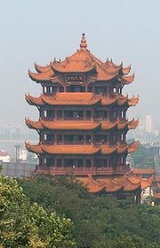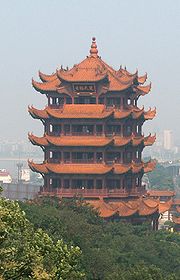
Yellow Crane Tower
Encyclopedia


Yangtze River
The Yangtze, Yangzi or Cháng Jiāng is the longest river in Asia, and the third-longest in the world. It flows for from the glaciers on the Tibetan Plateau in Qinghai eastward across southwest, central and eastern China before emptying into the East China Sea at Shanghai. It is also one of the...
in Wuchang District, Wuhan
Wuhan
Wuhan is the capital of Hubei province, People's Republic of China, and is the most populous city in Central China. It lies at the east of the Jianghan Plain, and the intersection of the middle reaches of the Yangtze and Han rivers...
, in Hubei
Hubei
' Hupeh) is a province in Central China. The name of the province means "north of the lake", referring to its position north of Lake Dongting...
province of central China
South Central China
South Central China is a region of the People's Republic of China defined by governmental bureaus that includes the provinces of Guangdong, Hainan, Henan, Hubei, and Hunan, and the Guangxi Zhuang Autonomous Region, however excluding the 2 special administrative regions : Hong Kong and...
.
History
Legend
There are at least two legends related to Yellow Crane Tower. In the first, an Immortal (仙人) name Wang Zi'an (王子安) rode off on a yellow crane from Snake Mountain. A tower was later built in commemoration. In the second, after becoming an Immortal, Fei Wenyi (费文祎) would ride a yellow crane and often stop on Snake Hill to take a rest.Poem by Cui Hao
Yellow Crane Tower was made famous by an 8th century poem written by Cui HaoCui Hao (poet)
Cui Hao was a Chinese poet of the Tang Dynasty in China.Cui Hao was born in Biànzhōu and passed the imperial examinations in 723. He is known to have traveled extensively as an official, particularly between the years 723-744. He was known for three poetry topic - women, frontier outposts, and...
called "Yellow Crane Tower" (黄鹤楼). The original text of the poem is shown below:
昔人已乘黄鹤去,此地空余黄鹤楼。
黄鹤一去不复返,白云千载空悠悠。
晴川历历汉阳树,芳草萋萋鹦鹉洲。
日暮乡关何处是? 烟波江上使人愁。
A modern English
English language
English is a West Germanic language that arose in the Anglo-Saxon kingdoms of England and spread into what was to become south-east Scotland under the influence of the Anglian medieval kingdom of Northumbria...
translation of the poem may follow as such:
Long ago a man rode off on a yellow crane, all that remains here is Yellow Crane Tower.
Once the yellow crane left it never returned, for one thousand years the clouds wandered without care.
The clear river reflects each Hanyang tree, fragrant grasses lushly grow on Parrot Island.
At sunset, which direction lies my home town? The mist covered river causes one to feel distressed.
Poem by Li Bai
There is another famous poem about it by Li BaiLi Bai
Li Bai , also known in the West by various other transliterations, especially Li Po, was a major Chinese poet of the Tang dynasty poetry period. He has been regarded as one of the greatest poets in China's Tang period, which is often called China's "golden age" of poetry. Around a thousand existing...
called "Seeing off Meng Haoran for Guangling at Yellow Crane Tower" (黄鹤楼送孟浩然之广陵). The original poem is shown below:
故人西辞黄鹤楼,
烟花三月下扬州。
孤帆远影碧空尽,
唯见长江天际流
A modern English
English language
English is a West Germanic language that arose in the Anglo-Saxon kingdoms of England and spread into what was to become south-east Scotland under the influence of the Anglian medieval kingdom of Northumbria...
translation of the poem may follow as such:
My old friends said goodbye to the west, here at Yellow Crane Tower,
In the third month's cloud of willow blossoms, he's going down to Yangzhou.
The lonely sail is a distant shadow, on the edge of a blue emptiness,
All I see is the Yangtze River flow to the far horizon.
Alternative translation:
My old friend bids a westerly farewell to Yellow Crane Tower,
In the misty blossoms of April as he goes down to Yangzhou.
His lone sail is a distant shadow disappearing in the azure void,
All I see is a long river flowing to the edge of heaven.
Tourism
The top of the tower has a broad view of the surroundings and the Yangtze River. Yellow Crane Tower is considered one of the Four Great Towers of ChinaFour Great Towers of China
The Four Great Towers of China are four towers famous in Chinese History for a variety of reasons. They refer to:* Yellow Crane Tower, Wuhan - * Pavilion of Prince Teng, Jiangxi - * Yueyang Tower, Yueyang - * Penglai Pagoda, Shandong - )...
. In its modern version it has the appearance of an ancient tower but is built of modern materials and includes an elevator as it was rebuilt in 1981. Displays are presented at each level. To the east on the hill, a large temple bell may be rung by tourists for a small fee. There are court dances in the western yard every year during the week long celebration of China's National Day (October 1).
Reference sources
- Wan, Jingjun 1982. Cui Hao Poem Annotations . Shanghai Ancient Books Press . 54 pages.

